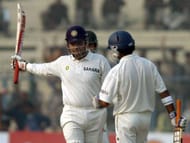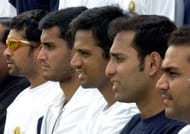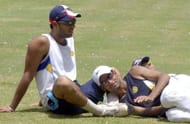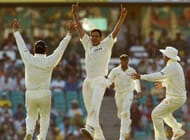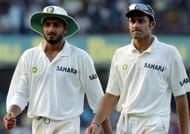The Indian cricket team were a very different side back in 2004 – 2005. It was a side that was emerging in world cricket as a force to be reckoned with. After the success of the 1983 World Cup, India produced a number of excellent cricketers from Mohammad Azharuddin to Sachin Tendulkar to Sourav Ganguly and Rahul Dravid, the Indian factory line was the gift that kept giving.
With that being said, the Indian ‘team’ was not a force that was to reckoned with. It wasn’t until Sourav Ganguly took over captaincy that the Indian team developed an aggressive streak, they were willing to put everything on the line to get the victory.
When Australia toured India in 2004 for a four-match Test series, the morale in the Indian camp had never been higher. They had returned from Pakistan with an incredible series win after having shared the spoils ‘down under’ in their previous assignment.
If India were in hot form at that moment, the Australian cricket team were simply unassailable as the best team in world cricket. On their tour to India in 2004, the Aussies went away with a handsome 2 – 1 win. It still remains the last time they won a series in India.
13 years later, we look at the Indian squad that lost to the Aussies back in the day.
Openers
Aakash Chopra
At that stage, India were producing a whole number of openers in the classical mould who could absorb the pressure and spend valuable time at the crease facing the new ball. Aakash Chopra was typically one of those cricketers.
Having fought hard for his place in the team, he was the recognized opener when the Aussies visited India. A poor run in the home series and the availability of other game-changers, like Yuvraj Singh, who opened in one Test in this series meant Aakash Chopra was relegated to the role of a squad player.
He recorded scores of 0, 5, 9 and 1 in the series at Bangalore and Nagpur. The Nagpur Test was the last time he represented India.
Gautam Gambhir
Supremely talented left-handed batsman Gautam Gambhir was one who was destined for success and was handed his chance to impress against the Aussies as he made his debut as a young 23-year-old.
In his debut match in Mumbai, he only managed to score 3 and 1 but his next outing, against South Africa, he scored an impressive 96 and it proved enough to convince the selectors to persist with him in Test cricket.
Virender Sehwag
Plagued with inconsistency in limited-overs cricket, Delhi dasher Virender Sehwag made an instant impact in Test cricket when he scored a century on debut away in South Africa. Sourav Ganguly convinced him to open the batting, a decision that would change his life and lead him to become one of the most destructive batsmen in Test cricket history.
When Australia toured India in 2004, he was one of the more successful batsmen for the hosts and had a fine series including a scintillating 155 in the drawn Test in Chennai. The Mumbai Test was the first time Indian fans were treated to the Sehwag-Gambhir partnership which would go on to lead India to many successes.
Middle-order
Rahul Dravid
India’s middle-order batsmen at that stage was undoubtedly one of the greatest set of batsmen to have ever batted together at the same time. Coming in to bat at number 3 was ‘the wall’ Rahul Dravid.
In the early 2000s, India were struggling to find a recognized opening combination and it meant Dravid would often have to walk in early on in a Test match with a repairing job to do. The series at home was one of the rare instances of Dravid failing, only managing to register one half-century in 4 matches.
Sachin Tendulkar
Arguably the greatest batsman to have ever played the game, Sachin Tendulkar was one of the senior members of the squad by 2004. Having debuted at the age of 16, he had experienced the ups and downs of international cricket by this stage.
Sachin was injured for the first half of the series and returned for the Nagpur Test by which stage India were 1 – 0 down. His half-century in the final Test at Mumbai helped India register their only win.
Sourav Ganguly
Sourav Ganguly’s reputation had grown to lofty heights as he spearheaded a successful revolution of the Indian cricket team and was enjoying a relative period of stability at this point in time.
Like Sachin, he too missed a couple of Tests in the series. He scored 45 in the first innings of the Bangalore Test, a valiant effort but certainly not enough as India went down. He returned for the Mumbai Test and led the side to victory.
VVS Laxman
The Australians were sick of the sight of the stylish right-handed batsman VVS Laxman by the time they toured India in 2004. Demons of his incredible 281 against them in 2001 were still relatively fresh in the memory and the Aussies were keen to exorcise them.
Despite having a career average of close to 50 against the Aussies, Laxman too struggled in the first three Tests but was back to his best in the final Test and his 69 in the second innings was key to India’s win.
Yuvraj Singh
Yuvraj Singh was being pushed aggressively in Test cricket after he had showcased his ability to be an absolute game-changer in ODIs since his debut in 2000. Despite being primarily a middle-order batsman, he was even played as an opener in one Test against Australia.
The Australia Test series came too early in his international career and the selectors only played him in the first two Tests. Despite going on to play a total of 40 Tests in his career, he would never have the success he enjoyed in other formats of the game.
Mohammad Kaif
Along with Yuvraj Singh, Mohammad Kaif represented a new brand of Indian cricketers who were fitter and faster than their previous generations. After the success during the Natwest Trophy, Kaif and Yuvraj were catapulted into fame and the selectors believed they should be a part of the team in all formats.
Against Australia, he would enjoy a better series than most batsmen as he recorded half-centuries in Chennai as well as Nagpur. Kaif only played a total of 6 Tests after the Australia series.
Parthiv Patel
Parthiv Patel would make headlines when he debuted for India in 2002 as a mere 16-year-old. The sight of him on the cricket field around players with much more experience is an image that Indian fans fondly recall.
When Australia toured India in 2004, he was the recognized wicket-keeper and would perform relatively well in the series before the selectors would decide to hand a debut to Dinesh Karthik in the final Test.
Dinesh Karthik
Much was expected of Dinesh Karthik as he made plenty of headlines climbing through the ranks as a wicket-keeper batsman. When he made his debut in the final Test against Australia, fans were excited as he was widely expected to be the wicket-keeper for years to come.
He would be India’s primary keeper for a period from 2004 – 2007 after he replaced Parthiv Patel but inconsistencies at the highest level meant he was replaced by MS Dhoni.
Bowlers
Irfan Pathan
Irfan Pathan possessed serious pace at this stage of his career and had the ability to make the ‘ball talk’ by swinging it both ways. He enjoyed limited success against Australia, picking up a total of 2 wickets in the first two Tests before being dropped to accommodate Ajit Agarkar in the squad.
Irfan Pathan became the darling of the Indian public after his unbelievable hat-trick against Pakistan in 2006. A series of injuries would ravage his playing career thereafter.
Ajit Agarkar
Ajit Agarkar’s Test career never took off like his ODI career where he was undoubtedly one of India’s biggest match winners in the late 90s and early 2000s. His success in the limited-overs format meant he was always lingering around the Test squad, never really cementing a place.
He replaced Irfan Pathan in the Nagpur Test but had even less success as he only managed 1 wicket. He went on to represent India in only 4 Tests after the Australia series.
Murali Karthik
Murali Karthik spent a career on the fringes as he always seemed one game away from cementing his place in the squad. Despite plenty of success in the domestic circuit, he could never break through the India squad in the early 2000s due to the presence of Harbhajan Singh and Anil Kumble.
Given a chance against Australia in the final two Tests, he enjoyed a lot of success, picking up 5 in Nagpur and a match-winning 7 in Mumbai. While one might have expected him to play more Tests after that, he only went on to represent his country one more time.
Zaheer Khan
Zaheer Khan had assumed the mantle of being India’s pace spearhead to perfection. Replacing the likes of Javagal Srinath and Venkatesh Prasad, he would go on to partner and assist a whole number of other bowlers during his time with team India.
He enjoyed limited success during the Australia tour of India however, picking up a total of 10 wickets over the 4 Tests. He picked up 6 wickets in Nagpur, a game India would go on to lose badly.
Harbhajan Singh
Like VVS Laxman, Harbhajan Singh was another who had tormented the Aussies in 2001 and was easily one of the most popular players in the Indian cricket team. During the early 2000s, he often proved to be the match winner for the team.
In 2004, he picked up an incredible 22 wickets in the Test series. Despite his best efforts in Bangalore, where he picked up two five-wicket hauls, the team went on to lose by 217 runs.
Anil Kumble
Anil Kumble was one of the veterans of the Indian cricket team in 2004 having made his debut back in 1990. His partnership with Harbhajan Singh was absolutely deadly over the years and still remains arguably India’s best bowling combination.
Kumble had an even better series than Harbhajan and took 27 wickets. In Chennai, his 13 wickets weren’t enough as the match ended in a draw.
Follow IPL Auction 2025 Live Updates, News & Biddings at Sportskeeda. Get the fastest updates on Mega-Auction and cricket news

